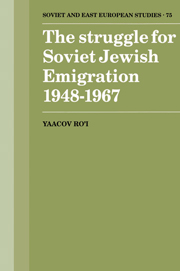Book contents
7 - A first breakthrough: November 1956–December 1959
Published online by Cambridge University Press: 31 October 2009
Summary
The Soviet Union had stopped issuing visas for emigration to Israel in October 1956 in retribution for Israel's “aggression” toward Egypt, yet a new opportunity for action presented itself toward the end of that year: a new Soviet-Polish repatriation agreement was signed which offered relatively large numbers of Jews the chance to leave the USSR. The agreement was supposed to be strictly limited to the repatriation to Poland of Poles or Jews who had been Polish citizens in September 1939 or the close relatives of such people. But the Soviet authorities seem to have been aware that Israel was the ultimate goal of those Jews who qualified to leave under its terms. And the fact that the repatriation movement to Poland was given official publicity inside the Soviet Union meant — at least to the less timid — that applying to leave the USSR under the agreement was a legitimate procedure. Indeed, for the three or so years of its duration, large numbers of Soviet Jews who did not fall into the categories specified in the agreement sought to take advantage of the opportunity it provided. These were chiefly Jews who resided in the areas most affected by the agreement, i.e. those that had belonged to Poland prior to World War II and were now incorporated into the Lithuanian, Belo-russian or Ukrainian SSR.
After the large-scale postwar emigration of their own Jews, at first to the DP camps in Germany and Austria and from 1948 on directly to Israel, had been cut off in 1950, the Poles did not begin reissuing exit permits for Israel until 1956.
- Type
- Chapter
- Information
- The Struggle for Soviet Jewish Emigration, 1948–1967 , pp. 251 - 285Publisher: Cambridge University PressPrint publication year: 1991



